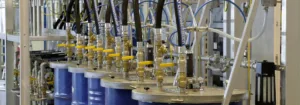The never-ending search for efficiency and sustainability in industrial operations has resulted in the development and integration of a wide range of innovative technologies. The air drive unit in air motors, a noteworthy accomplishment in pneumatic systems, is one such invention that has received notice. This technique uses compressed air to drive mechanical motion, providing several benefits in sectors ranging from manufacturing to automation.
Air Motors and Air Drive Units
An air motor is a device that is versatile and transfers the energy of compressed air into mechanical work. It works by expanding compressed air to provide rotational or linear motion. Air motors are praised for their ease of use, durability, and inherent safety in hazardous conditions. These characteristics make them a preferred alternative in a variety of situations where electrical or hydraulic power sources would be inconvenient or dangerous.
The air drive unit, which is responsible for converting pneumatic energy into motion, is at the heart of an air motor. Precision-engineered components like the rotor, cylinder, vanes, and endplates make up the air drive unit. These parts work together to transform the power of compressed air into usable mechanical work.

Functionality and Benefits
The air drive unit works in a cyclical manner. Compressed air is blown into the motor, expanding the air chambers, and spinning the rotor assembly. The rotor’s vanes follow the curves of the housing, allowing for smooth motion. Adjusting the airflow and pressure allows for fine control over the mechanical output by modifying the rotational speed and torque.
- Environmental Friendliness: Air motors and their drive units rely on clean, abundant compressed air. Unlike internal combustion engines, they produce no emissions, contributing to a cleaner working environment and a reduced carbon footprint.
- Safety: Since air motors don’t involve electrical components or sparks. They are ideal for use in explosive or flammable atmospheres, where safety is of paramount concern.
- Low Maintenance: Air motors have fewer moving parts compared to traditional motors. Resulting in lower maintenance requirements, and extended operational lifespans.
- Versatility: Air motors offer a wide range of speed and torque adjustments, providing flexibility for diverse applications.
- Compact and Lightweight: Motors and their drive units are often compact and lightweight. Whoch maks them suitable for installations where space is limited.
- High Power-to-Weight Ratio: Air motors boast an impressive power-to-weight ratio, a critical advantage in weight-sensitive applications. Their lightweight design, coupled with robust mechanical output, allows for streamlined integration without adding bulk. This feature is particularly valuable in aerospace, where weight savings translate to enhanced fuel efficiency and performance. In robotics and automation, the high power-to-weight ratio enables agile and precise operations, boosting productivity and cost-effectiveness.

Air motors and their driving systems have been integrated into many different sectors as a result of their versatility.
Conveyor systems, assembly lines, and other manufacturing equipment are all powered by air motors. In automated operations such as robotics and assembly work, where precision and dependability are crucial, the use of air motors is prevalent. These devices are chosen for offshore platforms and shipyards due to their endurance in hostile conditions. Air motors and drive units are excellent for mining applications due to their safety and durability, particularly in tight or explosive environments. When preparing food, chefs use air motors to avoid potential contamination from electrical components. Air motors are useful for aircraft applications, including regulating flaps and valves, due to their lightweight design and versatility.
Air motors reveal a crucial development in industrial technology with the introduction of the air drive unit. It caters to a variety of applications across sectors and embraces the concepts of effectiveness, safety, and sustainability. As industrial processes advance, creating a demand for more efficient and environmentally friendly solutions. We anticipate the increased adoption of pneumatic systems powered by air motors and their associated drive units.
Its unique and efficient functionality has made it an ideal choice of power for many of today’s applications. Are you looking for more information?
For further insights and detailed technical information, consult the Pocket Guide to Air Motors by Atlas Copco or Contact us directly.


